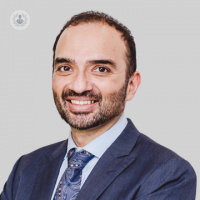An in-depth guide to cartilage injuries
Escrito por:In his latest online article, Mr Amir Qureshi gives us his in-depth guide to cartilage injuries. He discusses the most common type, how they occur, the treatment and if we can heal cartilage injuries without surgery.

What is the most common type of cartilage injuries?
Cartilage injuries may arise due to various factors, including acute incidents like a patellar dislocation, where the kneecap is displaced, leading to the removal of a portion of cartilage. Such occurrences may occur spontaneously, particularly during adolescence when a section of the knee's cartilage may become loose due to an underlying condition.
Additionally, genetic predisposition can make the cartilage softer than usual, consequently causing cartilage issues. Overall, the most common causes of cartilage injuries are genetic susceptibility and acute traumas.
How do cartilage injuries occur?
In terms of how they occur in terms of trauma we will discuss a common cartilage injury which is when the kneecap dislocates and as the kneecap falls off the side of the knee, the cartilage can be scraped off.
If a bone fracture extends into the knee joint, it can disturb the smooth cartilage covering, equivalent to the bristle on the end of a chicken leg, which is a highly specialised tissue enabling smooth joint gliding. Any damage to this cartilage can result in cracks and potholes, leading to pain. The most common cause of cartilage damage is the natural process of wear and tear, referred to as osteoarthritis.
As individuals age, some may experience a gradual breakdown of the cartilage, though not everyone. In more uncommon cases, the body's immune system may target the cartilage, as seen in conditions like rheumatoid arthritis, where the body mistakenly perceives cartilage as an adversary and attacks it, causing disruptions.
What is the most effective treatment for cartilage injuries?
Regarding the treatment of cartilage injuries, the approach depends on the cause and the patient's age. If the injury is recent, there is a limited timeframe in which a considerable amount of cartilage pieces can be reattached. For individuals who have lost cartilage some time ago and have specific areas resembling potholes rather than intact surfaces, those potholes can be filled. There are two types of biological repair strategies for this purpose.
One method involves an all-in-one procedure, where cartilage can be borrowed from non-weight-bearing areas. Cylinders or fragments of cartilage are placed in a mosaic pattern to fill the defect. This approach is known as mosaicplasty. Alternatively, different procedures can be employed, but the principle is similar. New materials acting as scaffolds for cells are used. Cells are extracted from other parts of the body, concentrated, and applied to the scaffold within the knee. The hope is that the cells in this concentrated solution can regenerate cartilage, leading to tissue formation in the pothole.
The most advanced biological treatment involves taking cell samples from a non-weight-bearing area of the knee. These samples are sent to a lab where the cells are multiplied by the millions. In the second procedure, the multiplied cells are implanted back into the knee. This method is known as autologous chondrocyte implantation.
Why are knee injuries so common in sports? Is the knee a fragile joint?
In terms of fragility, I wouldn't state that knee cartilage is more fragile than in other areas. However, in the sports most people engage in, the knee is prone to injury and bears the brunt of such injuries compared to other joints. Cartilage injuries can also happen in the shoulder, hip, and ankle; these areas are also observed to be vulnerable. However, the knee tends to experience more injuries due to the specific types of sports in which it is involved and the individuals we commonly treat.
Is there a way to heal cartilage related injuries without surgery?
When considering non-surgical treatments, one crucial factor is the biological age. Younger individuals have the ability to recover from minor cartilage injuries. To illustrate, a baby's skin is soft and recover’s well, while as one ages, the skin becomes wrinkled, and cartilage follows a similar pattern. The older a person gets, the less ability they have to recover.
Other reported biological treatments include the injection of PRP, or platelet-rich plasma, as it's commonly known. Some individuals have also tried injecting substances like fat cells and various compounds. Although there may be anecdotal evidence of these treatments being beneficial, the scientific literature does not wholeheartedly and clearly support these interventions. While there is an increasing amount of evidence suggesting PRP's potential as an adjunct treatment, more studies are required to establish its effectiveness definitively.
Mr Amir Qureshi is a highly respected orthopaedic surgeon with over 25 years of experience. You can book an appointment with Mr Qureshi today on his Top Doctors profile.


